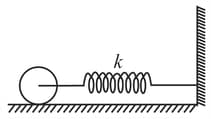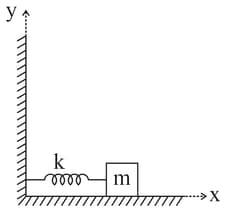The centre of a solid sphere of mass and radius placed on a rough horizontal plane is connected to a spring of stiffness as shown. An impulse is provided to the sphere at its mean position and the sphere starts oscillating. Find the period of oscillation, if there is no slipping anywhere


Important Questions on Oscillations
A body of mass is executing simple harmonic motion. Its displacement at seconds is given by . Its maximum kinetic energy is
In the following sentence, a blank space with four options is given. Select whichever preposition or determiner you consider the most appropriate for the blank space.
These are the good rules to live _____.
Two sentences are given below and you are required to find the correct sentence which combines both the sentences.
Which is the correct combination of the given two sentences?
He is too tired. He could not stand.
Total energy of a particle performing S.H.M. is NOT proportional to
Directions: Each of the following sentences in this section has a blank space and four words or group of words given after the sentence. Select the word or group of words you consider most appropriate for the blank space and indicate your response on the Answer Sheet accordingly.
Every rash driver becomes a ____ killer.
An object of mass is attached to a spring which is fixed at one end on a rigid support and the mass-spring system is kept on a frictionless table. The object is allowed to execute simple harmonic motion along - direction. The force constant of the spring is and the spring is stretched initially a distance of , the total energy stored in the system is


